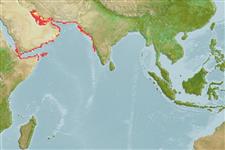>
Clupeiformes (Herrings) >
Dorosomatidae (Gizzard shads and sardinellas)
Etymology: Sardinella: Latin and Greek, sarda = sardine; name related to the island of Sardinia; diminutive (Ref. 45335).
More on author: Day.
Environment: milieu / climate zone / depth range / distribution range
Ecología
marino; rango de profundidad 0 - 50 m (Ref. 188). Tropical; 30°N - 10°N, 42°E - 74°E (Ref. 188)
Western Indian Ocean: Arabian Sea, from Gulf of Aden to the Persian Gulf and Bombay.
Tamaño / Peso / Age
Maturity: Lm ? range ? - ? cm
Max length : 17.0 cm SL macho / no sexado; (Ref. 188); common length : 14.0 cm SL macho / no sexado; (Ref. 188)
Espinas dorsales (total): 0; Radios blandos dorsales (total): 13-21; Espinas anales 0; Radios blandos anales: 12 - 23. Total number of scutes 31 to 34; lower gill rakers increasing with size of fish. Vertical striae on scales not meeting at center, only a few small perforations on hind part of scale. Closely resembles S. gibbosa which has fewer perforations on its scales. Of other sympatric Sardinella species, S. melanura has distinctive black caudal tips while S. albella has fewer scutes.
Coastal pelagic (Ref. 68964). Forms schools in coastal waters. Marketed fresh and dried-salted.
Life cycle and mating behavior
Madurez | Reproducción | Puesta | Huevos | Fecundidad | Larva
Whitehead, P.J.P., 1985. FAO Species Catalogue. Vol. 7. Clupeoid fishes of the world (suborder Clupeoidei). An annotated and illustrated catalogue of the herrings, sardines, pilchards, sprats, shads, anchovies and wolf-herrings. FAO Fish. Synop. 125(7/1):1-303. Rome: FAO. (Ref. 188)
IUCN Red List Status (Ref. 130435)
Threat to humans
Harmless
Human uses
Pesquerías: escaso valor comercial
Más información
Nombres comunesSinónimosMetabolismoDespredadoresEcotoxicologíaReproducciónMadurezPuestaAgregación para la puestaFecundidadHuevosEgg development
ReferenciasAcuiculturaPerfil de acuiculturaRazasGenéticaElectrophoresesheritabilidadEnfermedadesProcesamientoNutrientsMass conversion
ColaboradoresImágenesStamps, Coins Misc.SonidosCiguateraVelocidadTipo de nataciónSuperficie branquialOtolitosCerebrosVisión
Herramientas
Special reports
Download XML
Fuentes de Internet
Estimates based on models
Preferred temperature (Ref.
123201): 24.9 - 29.2, mean 26.9 °C (based on 172 cells).
Phylogenetic diversity index (Ref.
82804): PD
50 = 0.5000 [Uniqueness, from 0.5 = low to 2.0 = high].
Bayesian length-weight: a=0.00832 (0.00504 - 0.01373), b=3.00 (2.86 - 3.14), in cm total length, based on LWR estimates for this species & Genus-body shape (Ref.
93245).
Nivel trófico (Ref.
69278): 2.9 ±0.3 se; based on size and trophs of closest relatives
Resiliencia (Ref.
120179): Alto, población duplicada en un tiempo mínimo inferior a 15 meses (Preliminary K or Fecundity.).
Fishing Vulnerability (Ref.
59153): Low vulnerability (13 of 100).
Nutrients (Ref.
124155): Calcium = 321 [173, 498] mg/100g; Iron = 2.22 [1.31, 3.98] mg/100g; Protein = 20.6 [19.6, 21.5] %; Omega3 = 0.301 [0.148, 0.587] g/100g; Selenium = 98.3 [51.3, 191.7] μg/100g; VitaminA = 25.4 [8.5, 74.7] μg/100g; Zinc = 1.32 [0.96, 1.81] mg/100g (wet weight);
